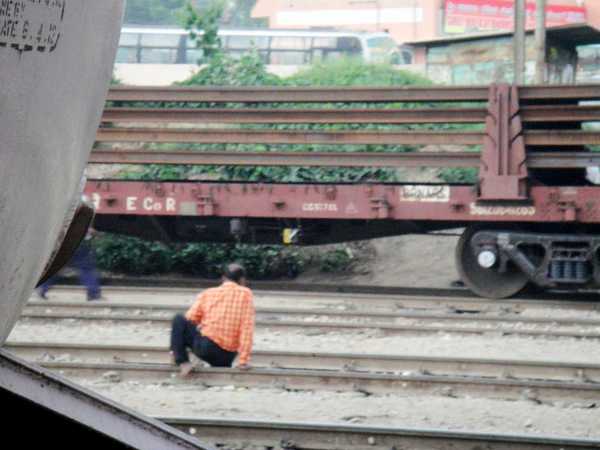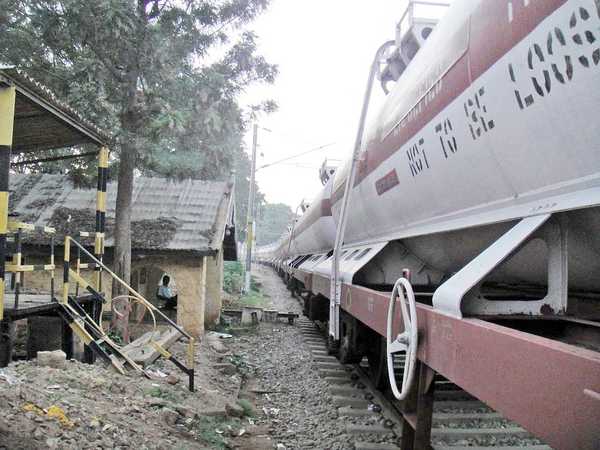Every morning and evening, sad scenes greet Kadugodi residents at this major point in Whitefield. The railway crossing that connects Kadugodi’s population to the bus stand and railway station has become a serious sore point for all in the area, and here’s why.
At any given time, there will be a goods train with endless carriages waiting for a signal to move. This makes crossing over a nightmare for all ages. In the mornings, when most people are rushing to the bus stand to reach office or school, this poses a great threat. Children and the elderly often have to squeeze down under the wagons or walk all the way till the end and then cross over.
insert the right 
Pedestrians try to squeeze through under the parked wagons. Pic: Ramesh Menon
At night, it is pitch dark and there is absolutely no visibility making it all the more difficult. Add to this the travails of having to carefully avoid the scattered human and animal feces.
Last month, we witnessed a series of casualties at this crossing; authorities, as usual, came up with interim measures such as police posting, and promises of a pedestrian overbridge soon. But, it all died down after a few days; now there is no police monitoring and the presence of the long train blocking the smooth passage of pedestrians has become a constant again.
Concerned authorities are aware of this, but they find it more convenient to pass the blame from one shoulder to another rather than do something to address this grave issue that affects the rich and poor, old and young, alike.
insert the right 
Pic: Ramesh Menon
As responsible residents, some of us requested authorities to approach this genuine citizen problem with more urgency, following which a senior railway official, V Sridhar – the Deputy Chief Engineer/Central (Construction) – responded, apprising us of the following facts:
- In the initial plan for a road overbridge, no provision was made for the construction of a foot overbridge at the above location. (This is plausible, and might be for the simple reason that the plan for the road overbridge had been prepared long ago when Whitefield had clearly not seen development of this magnitude, so that the foot traffic at the tracks was also negligible. However, as regular users, what is more disconcerting for us is the fact that there were no specifications for the width of the road over bridge, pedestrian convenience had not even been considered and there is no process for revision of the old plan based on present needs. The actual work of this over-bridge happened only recently.)
- Railways, though not obliged to do so, has agreed to execute the work as well as share the cost of work with the BBMP, solely with the interest of closing the level crossing to put an end, once and for all, to the recurring expenditure of maintaining the crossing.
- With the Railways already having constructed the road overbridge, when the need arose for a pedestrian overbridge, it was expected that BBMP would come forward to foot that bill.
- Finally, with the BBMP agreeing, Railways invited a tender for the project without any delay. This was opened on 27.12.2012, though the funds had not been deposited by BBMP till then. Invitation of tender without availability of funds, which is normally never done, was permitted in this case only in the interest of expeditious completion of the work.
- The same tender, which would in normal course have taken 2-3 months for finalisation, was finalised in just 20 days. This is reportedly a record for Indian Railways.
Railways has not received the funds for the above work from BBMP till date and has been continuously chasing the authorities for the same. At the same time, they have been trying to ensure that the agency does not stop the work (though it will not receive a single rupee till the funds are actually transferred to the Railways).
insert the right 
Goods train parked at the Kadugodi railway crossing. Pic: Ramesh Menon
In the same response, the official has also mentioned that a joint inspection was conducted on 17th January, 2013 and the work towards removal of obstructions has already commenced. This, according to him, is yet another record of the Indian Railways – where the work was taken up on the very next day of the award of the tender. They now look forward to establishing a third record by completing the project faster than any other!
The letter also mentions that reports from security authorities indicated that either one or both of the deceased in accidents on January 2nd had been talking on their mobile phones while trying to cross the tracks, even though there is no way to ascertain the veracity of such a claim now.
I have been assured that in the entire episode, "there was no apathy, there were no petty egos and there was no inability to act on the part of Railways" and have been exhorted to look at facts before blaming any particular authority.
On our part, as concerned citizens who are affected everyday, we can only continue with our plea to BBMP and Railways along the following lines.
The most helpful, proactive action from Railways would be to move the parked goods wagons by around 50 metres towards the Chennai side by a suitable arrangement, thus clearing the obstruction of path at the level crossing. Wagons parked overnight or for long hours block the view of both sides for pedestrians.
Aged persons/children/women are often found to be crawling beneath the parked wagons to cross over to the other side while others climb over the wagons, risking their lives. Also, wagons parked beyond the crossing require people to walk on the tracks. There could easily be oversight or some negligence in such a case, resulting in loss of human lives.
The two sides, where one could cross, are also not easy to navigate as there is hardly any space between the wagons and the bund. Also, there is filth and water from the gutters everywhere.
The darkness in the area makes it worse. The safety of women, so much in focus now, makes it even more important to provide lights in the vicinity of the crossing.
A concrete pathway which had existed earlier, before the closure of the railway crossing, enabled people to cross faster and may merit reconsideration. And the presence of security personnel to guide pedestrians is imperative till the foot-bridge is completed.
As residents of the area, we all appreciate the Railways’ good intention and their interventions to minimise the problem until BBMP gets into the act. At the same time, we urge BBMP to act without any delay in progressing the work before we hear of another tragedy.
I also seek support of all resident associations, corporate organizations and their staff and political parties, irrespective of any difference in ideologies, in this cry for a safe system to cross the tracks. Otherwise, for residents of Kadugodi, the way to the bus stand is always going to be down and under. ⊕